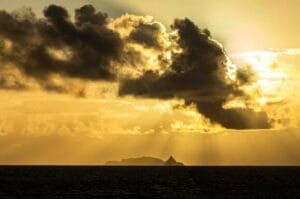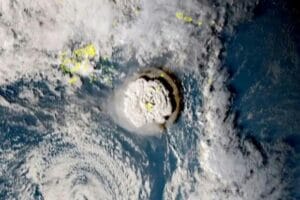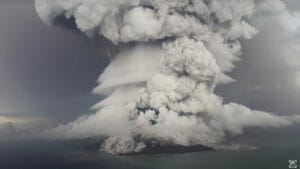A team of scientists led by New Zealand said Monday that the catastrophic volcanic explosion in Tonga in January was the greatest ever observed using current technology.
Tonga Volcanic Eruption causes Havoc
In the Pacific island nation of Tonga, the Hunga Tonga-Hunga Ha’apai volcano erupted underwater with the force of hundreds of atomic bombs, causing a 15-meter (50-foot) tsunami that destroyed homes and claimed at least three lives.
The natural disaster also hampered efforts to aid the victims by damaging underwater communication cables that cut Tonga off from the rest of the world for weeks.

The eruption blew out almost 10 cubic kilometres of material, which is equal to 2.6 million Olympic-sized swimming pools, and sent debris more than 40 kilometres (25 miles) into the mesosphere, the layer above the Earth’s stratosphere, according to a thorough study by New Zealand’s national institute for water and atmospheric research.
According to marine scientist Kevin Mackay, “the eruption reached record heights, being the first we’ve ever observed to break through into the mesosphere.”
It was like a shotgun explosion fired straight up into the sky, added Mackay.
The Krakatoa disaster, which claimed tens of thousands of lives in Indonesia in 1883 before the development of current measurement technology, is comparable to the Hunga Tonga-Hunga Ha’apai eruption.
Tonga Volcanic Eruption Further Triggered Huge Tsumami Waves
The distinction here is that it’s an underwater volcano, which is also one of the reasons we had such massive tsunami waves, said Mackay. “This eruption was large—one of the greatest since Krakatoa.

Three-quarters of the material ejected by the Tongan eruption have been explained by the scientific team, with the remaining portion being explained as debris spread in the atmosphere.
Approximately two cubic kilometres of particles, which lingered in the atmosphere for “months, generating the spectacular sunsets we saw,” according to Mackay, were thought to have been confined in the plume, which spread as far away as New Zealand in the Pacific.
Additionally, his team found that the volcano’s crater has receded 700 metres.
Debris from the volcano was carried along the ocean floor at least 80 kilometres away by the eruption’s pyroclastic flows, which are deadly currents of lava, volcanic ash, and gases that can reach temperatures of 1,000 degrees Centigrade (1,800 degrees Fahrenheit) and speeds of 700 kilometres per hour.
Emily Lane, the team’s chief scientist, claimed that the pyroclastic flows “appears to stretch beyond that, potentially as far as 100 kilometres away.”
We found deposits in valleys beyond the volcano, indicating that the flows had the power to flow uphill over enormous slopes and then back down. The sheer energy of the flows is astounding.
Also read- This Weekend, A Nasty Cold Front Will Deliver Houston The ”Worst Terrible Day of 2022”

